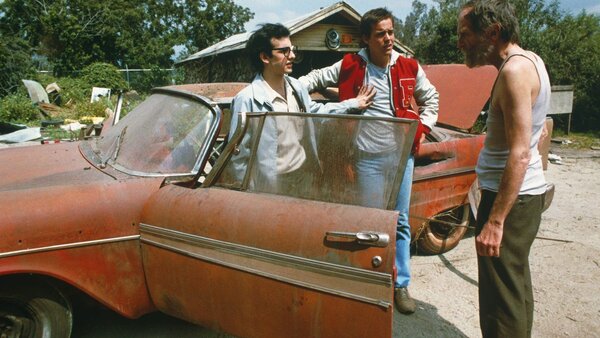Why CHRISTINE Is Secretly The Best Stephen King Movie
John Carpenter's Christine - A Fiery Reckoning With Fifties Nostalgia

The main story of Christine revolves around three teenagers in their last year of high school. There's Dennis Guilder (John Stockwell), a confident, good-looking football player with a bright future, Leigh Cabot (Alexandra Paul), a bookish but attractive newcomer to the school who's turning everyone's heads, and then lastly there's Arnie Cunningham, a nerdy, frustrated teenager whose social life is being smothered by his oppressive parents. Keith Gordon gives the best performance of the film as Arnie, selling his dark transformation from shy geek to angsty '50s bad boy superbly, all of which is of course onset by the eponymous car in question, which our young protagonist acquires after a torrid first day back at school.
The opening scenes of Christine establish a few things primarily, but the lasting impression is one of profound contrast and yet also endurance, with Carpenter rooting the story immediately within the 1950s and then carrying those historical conventions over into the film's contemporary setting of 1979. The establishing scene starts in a factory in 1957, a bright and colourful production line cranking out gleaming sedans while George Thorogood's "Bad to the Bone" plays.
Christine stands out immediately as an aberrant and ominous creation, her red paint and interior a stark contrast to the white cars that rolled off before and after. Soon enough, she starts inviting attention, wounding one factory worker before killing another who spilled ash over her upholstery. Buddy Holly's "Not Fade Away" blares in loudly over the radio, before the scene transitions to a cold and blue-looking '79, with Dennis behind the wheel of his '68 Dodge Charger - the same song playing.
The opening credits and introductory scenes of Christine are excellent just for the tension they build and the personality they imbue into the titular car, but what's so clever about them is that they immediately present the thematic framework of the story. The opening scene shows fifties industry at its most prosperous, a conveyor belt of manufacturing cranking out gorgeous cars while a punchy rock n' roll track plays overhead. There's a warmth to the depiction which is then given ironic dissonance with Christine's violence, a dissonance that manifests differently when we get to '79, and the warm colour palette is swapped for blues, greys and blacks, albeit with Buddy Holly still playing.
The end result is that Carpenter enshrines violence and horror in the fifties setting, and establishes a throughline of cultural continuity into 1979 - first with Buddy Holly and Dennis' car, and then with the introduction of Arnie and the high school ecosystem, which comes across as a depressing, post-Watergate amalgamation of American Graffiti, Grease, and Happy Days.
In short, these two sequences intimate the most compelling themes of Christine and how the film comments on the politics of memory - specifically the 1950s and how it became codified into popular and political culture in an era of American decline, before eventually giving way to the 1980s, and a political conservatism entrenched in post-war nostalgia. Christine embodies all of that in her sleek, crimson chassis, with the evil lurking underneath serving to unmask the sinister portrait of those fifties comforts.
[Article continues on next page...]